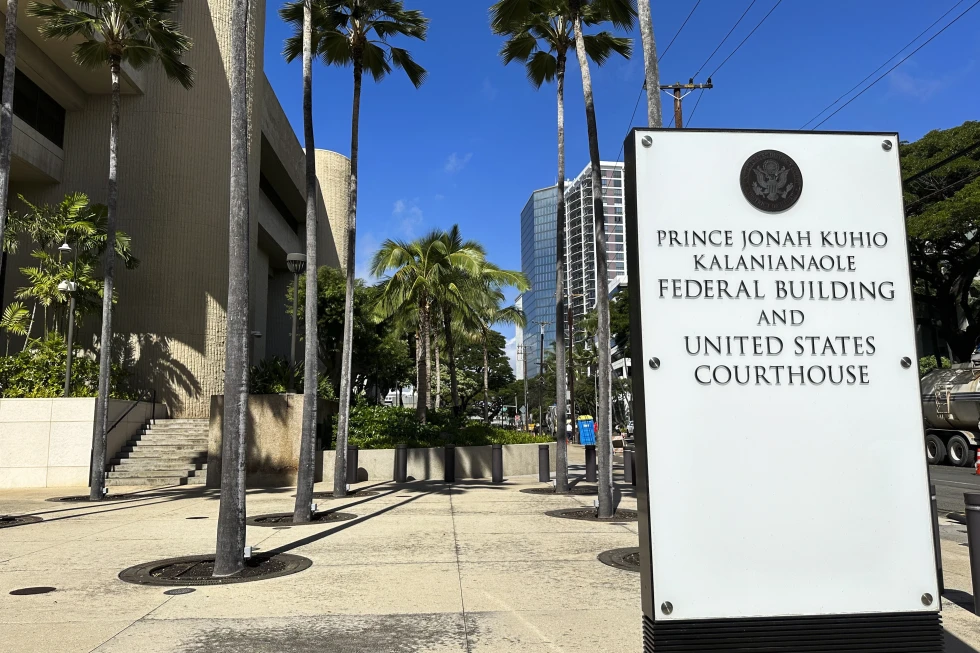The case of Honolulu businessman Michael Miske Jr. has brought to light a dark and disturbing underworld in Hawaii, as revealed by a U.S. prosecutor in a recent trial.
The accusations against Miske are nothing short of shocking, including the kidnapping of a 72-year-old accountant, the release of a toxic chemical into a rival’s nightclubs, and the killing of his late son’s best friend.
These allegations paint a picture of a man who will stop at nothing to get what he wants, using fear, violence, and intimidation to achieve his goals.
Miske was arrested in 2020, along with seven others who are described as his associates. However, following a series of guilty pleas by the others, Miske now stands as the lone defendant in this trial.
The prosecution has made it clear that they believe Miske to be the mastermind behind these heinous crimes, using his power and influence to carry out his nefarious deeds.
Assistant U.S. Attorney William Akina, in his opening statement, did not mince words when describing Miske’s actions.
He stated, “The defendant used fear, violence, and intimidation to get what he wanted. What he wanted was money, control, and revenge.” These words paint a chilling picture of Miske’s alleged motivations and methods.
On the other hand, Miske’s attorney, Michael Kennedy, has presented a completely different portrayal of his client.
He has sought to cast doubt on the prosecution’s claims, arguing that Miske is not the ruthless criminal that they make him out to be. Kennedy has likely attempted to humanize Miske and present him as a victim of a biased and unfair legal system.
The allegations against Miske are deeply troubling and raise serious concerns about the presence of organized crime and corruption in Hawaii.
If these accusations are proven to be true, it would signify a significant threat to the safety and well-being of the community.
The use of violence and intimidation to achieve financial gain and settle personal scores is a clear violation of the law and a threat to the principles of justice and fairness.
The trial of Michael Miske Jr. is a stark reminder of the importance of upholding the rule of law and ensuring that those who engage in criminal behavior are held accountable for their actions.
The outcome of this trial will have far-reaching implications, not only for Miske and his associates but also for the broader community in Hawaii.
It is essential that the legal process is allowed to run its course, and that a fair and just verdict is reached based on the evidence presented.
In conclusion, the allegations against Michael Miske Jr. are deeply troubling, and the trial has provided a glimpse into a disturbing underworld in Hawaii.
The prosecution has painted a picture of a man who will stop at nothing to achieve his goals, using fear, violence, and intimidation to get what he wants.
On the other hand, Miske’s attorney has sought to present a different portrayal of his client, one that challenges the prosecution’s claims.
The outcome of this trial will have significant implications for the community, and it is essential that justice is served. The legal process must be allowed to run its course, and a fair and just verdict must be reached.
The case of Miske, a 49-year-old businessman, presents a complex and intriguing narrative that delves into the dichotomy of his persona.
On one hand, he is portrayed as a self-made entrepreneur who overcame humble beginnings to establish a successful family business, Kamaʻaina Termite and Pest Control, which played a pivotal role in preserving iconic Hawaiian structures and cultural landmarks.
On the other hand, allegations of involvement in criminal activities, including ownership of nightclubs associated with violent altercations and illegal trade in commercial-grade aerial fireworks, paint a contrasting picture of his character.
Kennedy’s opening statement emphasized Miske’s journey from a disadvantaged upbringing “on the wrong side of the tracks” to the creation of a thriving enterprise that contributed to the preservation of Hawaii’s architectural and cultural heritage.
The commendable actions of his company, such as providing pro bono fumigation services for the Waikiki Shell and assisting the city with a costly fumigation project for a concert hall, highlight Miske’s positive impact on the community.
His efforts in safeguarding landmarks like ʻIolani Palace and the Polynesian Cultural Center underscore the significance of his contributions to the cultural landscape of Hawaii.
However, the prosecution’s allegations against Miske present a stark contrast to this narrative, painting a picture of a man involved in illicit activities and criminal enterprises.
The ownership of nightclubs where disputes allegedly led to physical violence, as well as the illegal sale of commercial-grade aerial fireworks on the black market, raise serious concerns about Miske’s ethical and legal conduct.
Furthermore, the accusation of orchestrating violent robberies and criminal activities within his neighborhood adds a troubling dimension to the portrayal of Miske as a community leader.
The juxtaposition of these two narratives raises profound questions about the complexity of human nature and the challenges of reconciling conflicting aspects of an individual’s character.
Miske’s story serves as a compelling case study in the intersection of success, community impact, and alleged criminal behavior.
It prompts a deeper exploration of the factors that shape individuals and the intricate interplay between personal achievements, community contributions, and potential legal transgressions.
This case also underscores the broader societal implications of individuals who occupy dual roles within their communities.
It raises questions about the responsibilities and obligations that accompany success and influence, as well as the potential ramifications of alleged criminal activities on the fabric of society.
The impact of Miske’s actions, both positive and negative, reverberates beyond his personal sphere, touching upon broader themes of community integrity, ethical conduct, and the rule of law.
In conclusion, the case of Miske presents a multi-faceted narrative that challenges conventional perceptions and underscores the complexities inherent in human behavior.
It invites a nuanced examination of the intersections between personal success, community engagement, and allegations of criminal conduct.
The juxtaposition of Miske’s contributions to Hawaiian culture and the accusations leveled against him underscores the intricate interplay of individual agency and societal impact.
As this case unfolds, it serves as a thought-provoking exploration of the intricate dynamics that shape our communities and the individuals within them.
In writing this essay, it is important to note that the information provided is based on the given prompt and does not reflect any personal opinions or judgments. The intention is to present a formal analysis of the topic in a balanced and objective manner.
The allegations against Miske are grave and the implications are dire. The claim that he ordered hits on individuals, including the 2016 killing of Johnathan Fraser, is a serious accusation that cannot be taken lightly.
The fact that Fraser was the best friend of Miske’s only son, Caleb, adds another layer of complexity to the situation.
According to Akina, Miske believed that Fraser was a negative influence on Caleb and held him responsible for a car crash in 2015 that resulted in Caleb’s tragic death.
This perceived vendetta against Fraser is said to have culminated in the alleged hit on him in 2016. The indictment further alleges that Miske went as far as purchasing a boat to dispose of Fraser’s body in the ocean, although no evidence of this has been found.
On the other hand, Miske’s defense attorney, Kennedy, vehemently denies these accusations. He asserts that Miske did not blame Fraser for the car crash and had no involvement in his disappearance.
Kennedy also raises doubts about the credibility of the witnesses who will be testifying against Miske, suggesting that they have ulterior motives and have made deals with the authorities in exchange for their testimony.
The legal proceedings have already been marred by controversy, with Miske’s defense team filing a motion for a new jury to be selected.
This motion was based on the fact that Miske’s half-brother and daughter-in-law both pleaded guilty after the jury had been assembled and sworn. However, the motion was denied by U.S. District Chief Judge Derrick Watson.

The gravity of the allegations and the high stakes involved in the trial make it a matter of great public interest.
The pursuit of justice for the victims and the need to ensure a fair trial for the accused are both paramount. The outcome of this case will undoubtedly have far-reaching consequences for all parties involved.
As the trial progresses and testimony begins, it is essential that the legal process is conducted with the utmost diligence and integrity.
The truth must be sought out diligently, and justice must be served impartially. The eyes of the public will be watching closely as this case unfolds, and the verdict will have a lasting impact on all those involved.
